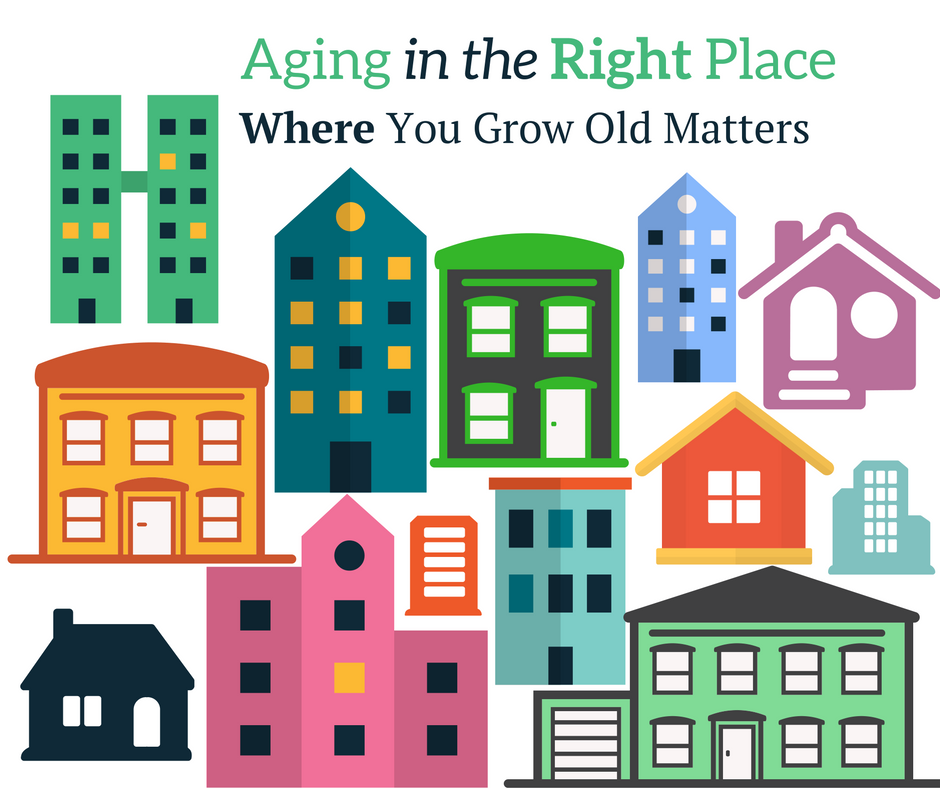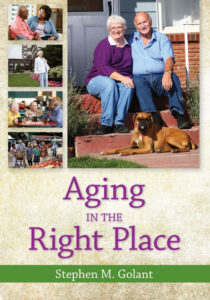
Q&A with Stephen Golant
Author of Aging in the Right Place

Stephen Golant, Ph.D. is a professor at the University of Florida (Gainesville). His research focuses on the housing, community, mobility, transportation, and long-term care needs of older adults populations and he writes and lectures extensively on this topic. Known as a expert in aging and housing, he is frequently called on by corporations, universities, state government agencies, and national organizations as a lecturer and adviser.
HPP sat down with Dr. Golant to discuss aging in place, and whether it’s the right choice for everyone.
Why is aging in place becoming the mainstream choice of older adults, and is it realistic?
Today we tell our older population they shouldn’t get old, and give them all kinds of counsel as to how to keep looking and acting young—from Botox, preventive health, hormones, and keeping active as volunteers. Therefore, it is hardly surprising that today’s old want to deny that they are getting older. Staying put and keeping relatively independent in their own dwellings makes this happen—but this does not work for everyone and it may not be good for you or your clients. Chronic health problems or physical limitations can contribute to the need to change your environment.
Your book covers a diverse array of housing options. What are some residential alternatives out there?
There are many. Shared housing, active adult communities, living with a family member, senior co-housing, affordable rental housing, independent living communities, assisted living developments, are just a few examples.
Your lectures and shorter writings all concern the housing needs and long-term care of older adults populations. What was the final push to write a full-length book about the matter? Why this book at this time?
I observed a very strong interest by older persons, family members, and private, public, and nonprofit sectors to identify solutions that would improve the quality of the housing and long-term care settings occupied by older adults. And while there was no shortage of information focused on this topic, what was lacking was a comprehensive examination of not only what housing and care problems older people face as they age, but a careful overview of their alternatives. So this book provides a full picture of the strengths and weaknesses of the housing and long-term care options open to older people and family members, and provides a single reference source for academics, and advanced undergrad and graduate students.
You place particular emphasis on the importance of older people having good information. What are some of the things people need to look out for or pay attention to?
Older adults have multiple needs requiring a diverse array of care and housing responses, so accurate and thorough knowledge about how to care for yourself, where to live, and what types of services to turn to when you grow old are essential topics to consider. Older adults should be asking themselves: How is my health? Do I have any impairments? How high are my housing costs currently? Do I have friends or family around to provide assistance?
What advice would you give to older adults who are looking into alternative housing?
Many older people would improve the quality of their lives and care if they moved into places such as independent living communities, assisted living developments, or continuing care retirement communities (now known also as Life-Plan Communities). But consumer beware. Like any product or service, there are gems and then there are bad apples. It’s important to visit a potential alternative at least a couple of times to actually see its operations and activities up-close. Try to talk to residents or those who already have family in these places.
The Area Agencies on Aging funded under the Older American’s Act do a tremendous service for those seeking counsel.
A major point you make in your book is a model of “residential normalcy.” What is this and how can it be achieved?
Residential normalcy is a way to measure residential satisfaction. When a person is living is a place that gives them pleasure and enjoyment, and where they feel competent, empowered, and in control…then they have achieved residential normalcy. By using this framework, we can better understand how older adults feel about their changing circumstances and how to effectively cope with the problems of where they live. The heart of this book is the often overlooked emotional challenges people face as they grow older and need to reconsider their housing situation. And you’ll see the book is filled with opinions, stories, and quotes from older adults themselves, to provide excellent insight into these challenges.
How important is technology to aging in place well? Why?
Still relatively unimportant but clearly growing in importance. Most products are now being introduced in planned long-term care settings such as independent living communities, assisted living properties, and continuing care retirements communities because they are viewed as potential cost-savings tools (compared with staffing costs) that will improve the health outcomes of their residents.
However, unquestionably, as new generations enter old age who have “grown up” with more rapid technological change, the rate of adoptions will certainly go up. This will be a hot topic in the future.
You mention that there is no one-size-fits-all solution for where older people should grow old. Despite this, do you think your book sends a hopeful message about the quality of the housing occupied by older people?
Absolutely. Although the majority of persons after they turn 65 will find themselves incongruous living arrangements at some point in their remaining lives, this is not the end game. Older persons confronting adversity can take steps to improve the quality of their lives. The hallmark of successfully aging older adults is to be proactive, to be agents of change.
American society offers its older constituencies a plethora of housing and service options that enable them to once again experience residential normalcy—achieve their residential sweet spot. To be sure, not all older people have equal coping opportunities. Some have more resilient personalities and more favorable demographics (such as income, educations, etc.) and some occupy more age-friendly places—where both the private and public leaderships have created more appropriate housing and service alternatives. Still, I’m optimistic.
Read the book!
Aging in the Right Place
By Stephen M. Golant, Ph.D.
Copyright © 2015 by Health Professions Press, Inc.
Plan ahead by learning the pros and cons of available residential settings for older adults in this essential gerontology text that tackles the question of how to grow old successfully.
Additional Resources:
Recommended Reading:
- Do You Really Want to Age in Place? (Forbes, 3/23/15)
Interview with Aging in the Right Place author Stephen Golant, on the pros and cons of aging in place, and the residential options out there for older adults. - Expert advice for the over 55-crowd (The Boston Globe, 3/14/15)
From a single-family house in a gated community to an apartment on a college campus, the choices seem endless. Advice on sorting through the options. - Aging in place concept has been oversold, professor argues (The Washington Post, 3/5/15)
Aging in the Right Place author Stephen Golant argues that aging in place might not be all it’s cracked up to be.


We’re a bunch of volunteers and opening a brand new scheme in our community. Your website offered us with valuable info to work on. You’ve done a formidable job and our entire neighborhood can be thankful to you.